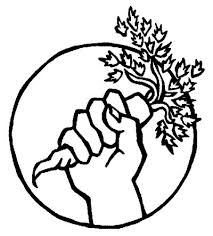I and the Village. 1911
Oil on Canvas, 192.1 x 151.4 cm
Mrs. Simon Guggenheim Foundation

Painted the year after Chagall came to Paris, I and the Village evokes his memories of his native village, peasants and animals lived side by side, in a mutual dependence here signified by the line from peasant to caw, connecting their eyes.
The peasant's flowering sprig, symbolically a tree of life, is the reward of their partnership. For Hasids, animals were also humanity's link to the universe, and the painting's large circular forms suggest the orbiting sun, moon (in eclipse at the lower left), and earth.
The geometries of I and the Village are inspired by the broken planes of Cubism, but Chagall's is a personalized version. As a boy he had loved geometry: "Lines, angles, triangles, square, he would later recall", "carried me far away to enchanting horizons." Conversely, in Paris he used a disjunctive geometric structure to carry him back home.
Where Cubism was mainly an art of urban avant-garde society, I and the Village is nostalgic and magical, a rural fairy tale: objects jumble together, scale shifts abruptly, and a woman and two houses, at the painting's top, stand upside-down.
"For the Cubists," Chagall said, "a painting was a surface covered with forms in a certain order. For me a painting is a surface covered with representation of things... in which logic and illustration have no importance."
http://www.moma.org/collection/browse_results.php?object_id=78984




Aucun commentaire:
Enregistrer un commentaire